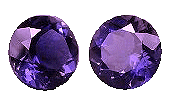Iolite Value, Price, and Jewelry Information
This stone, which represents one of the few relatively available and affordable blue stone options, is rapidly gaining in popularity. Arguably the gain is due more to exposure in mail order catalogs and on cable shopping channels than to promotion by traditional jewelry stores. Run of the mill stones often have a steely, inky or washed out blue color, but the best specimens can rival AAA tanzanite in the saturation of their blue-violet hue.
1 Minute Read
This stone, which represents one of the few relatively available and affordable blue stone options, is rapidly gaining in popularity. Arguably the gain is due more to exposure in mail order catalogs and on cable shopping channels than to promotion by traditional jewelry stores. Run of the mill stones often have a steely, inky or washed out blue color, but the best specimens can rival AAA tanzanite in the saturation of their blue-violet hue.
Start an IGS Membership today
for full access to our price guide (updated monthly).Iolite Value
This stone, which represents one of the few relatively available and affordable blue stone options, is rapidly gaining in popularity. Arguably the gain is due more to exposure in mail order catalogs and on cable shopping channels than to promotion by traditional jewelry stores. Run of the mill stones often have a steely, inky or washed out blue color, but the best specimens can rival AAA tanzanite in the saturation of their blue-violet hue.
Iolite is frequently step cut to enhance color and often windowed and/or shallow cut to lighten tone. The cutter must orient the rough carefully, taking iolite's trichroism of blue, gray and near colorless into account. So far, no treatments have been successfully used to lighten color or to remove inclusions, so one can assume that gems are untreated.
Its hardness of 7-7.5 makes it a suitable jewelry stone, though the presence of cleavage must be taken into account and some care exercised. Most of the iolite in world commerce comes from India, but substantial amounts are also mined in Tanzania, Brazil and Sri Lanka.
VALUE CONSIDERATIONS
Sinkankas lists the wholesale value of fine blue violet stones in the 1 to 5 carat range as $60 to $80 per carat and $100 to $150 per carat for stones 5 to 10 ct. He also notes that stones larger than 8 carats are rarely eye clean. Federman is more conservative, listing retail values as $100 and $150 per carat, respectively, for those size ranges. Writing in 1990 he reports that German cutters have been buying iolite rough in quantity to capitalize on an expected surge in popularity and price.
Barbara Smigel, PhD. GG
Barbara Smigel is a GIA Graduate Gemologist, faceter, jewelry designer, gem dealer, gemology instructor and creator of the well-regarded educational websites acstones.com and bwsmigel.info.
Related Articles
What is Gemstone Pleochroism?
Iolite Buying Guide
Unique Gem Materials for Jewelry Design
Gemstone Orientation for Beginners
Latest Articles
Pearl Simulants: How to Spot Faux Pearls
Opal Buying Guide
Amethyst Sources Around the World: The Geological Story Behind These Purple Gemstones
Brazilianite Value, Price, and Jewelry Information
Never Stop Learning
When you join the IGS community, you get trusted diamond & gemstone information when you need it.
Get Gemology Insights
Get started with the International Gem Society’s free guide to gemstone identification. Join our weekly newsletter & get a free copy of the Gem ID Checklist!
